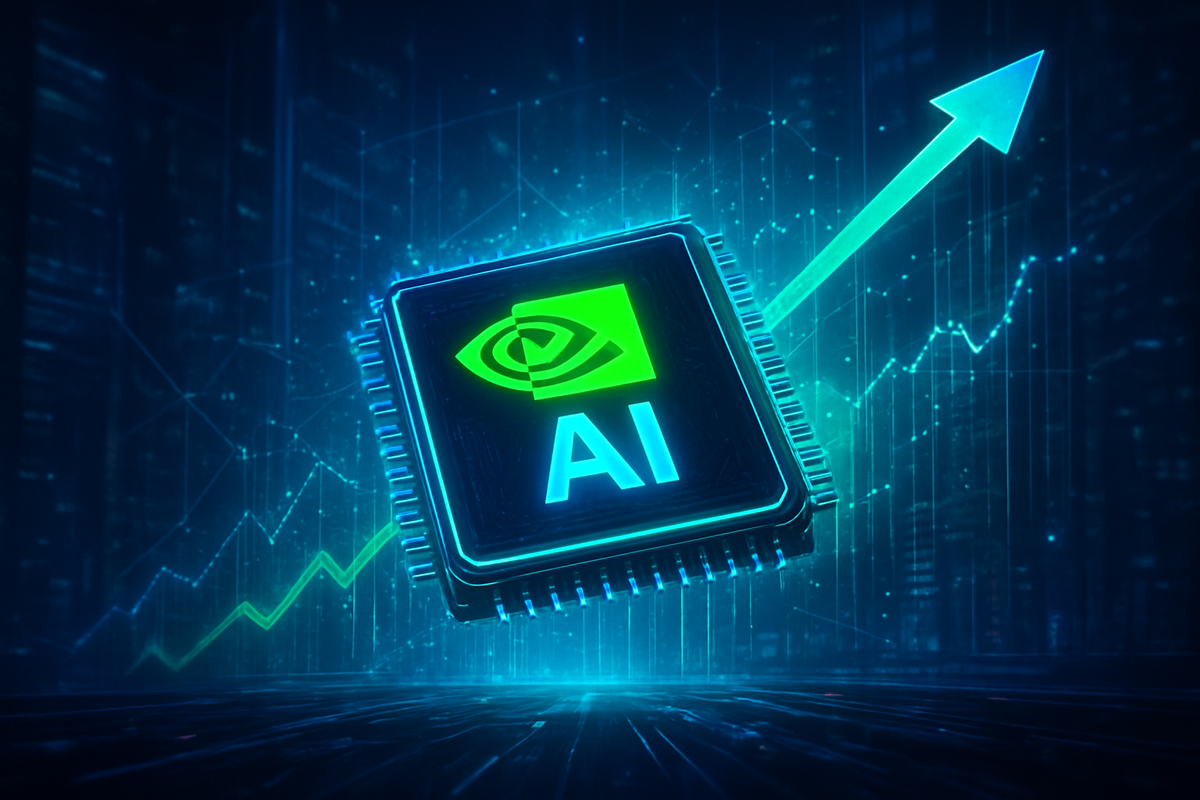
Nvidia (NASDAQ: NVDA) has once again captivated the financial markets with a blockbuster earnings report for its third quarter of fiscal year 2026, delivered on November 19, 2025. The semiconductor giant's stellar performance has not only sent its stock soaring but has also significantly rekindled faith in the broader artificial intelligence (AI) trade, effectively soothing widespread concerns about an impending "AI bubble." This report serves as a powerful testament to the enduring and accelerating demand for AI infrastructure, solidifying Nvidia's pivotal role in the ongoing technological revolution.
The immediate implications are clear: the AI boom is far from over, and the market's appetite for advanced computing power, particularly for training and deploying large language models, remains insatiable. Nvidia's results have provided a much-needed shot of confidence, suggesting that the massive investments pouring into AI are grounded in tangible demand and robust growth, rather than speculative exuberance.
Nvidia's Dominance Underscored by Record-Breaking Performance
Nvidia's Q3 fiscal year 2026, which concluded on October 26, 2025, showcased unprecedented financial strength. The company reported a record $57.0 billion in total revenue, marking an astounding 62% increase year-over-year and a 22% sequential rise from the previous quarter. This figure comfortably surpassed Wall Street's already high expectations of approximately $54.9 billion. Adjusted earnings per share (EPS) followed suit, reaching $1.30, a 60.5% year-over-year increase, outpacing analyst consensus.
The Data Center segment remained the primary growth engine, achieving a record $51.2 billion in revenue. This represents a staggering 66% year-over-year increase and a 25% jump from the prior quarter, accounting for approximately 90% of Nvidia's total revenue. This surge was primarily driven by "off the charts" sales of Nvidia's Blackwell platform and fully sold-out cloud GPUs, as hyperscalers and major tech clients continued to ramp up their AI infrastructure spending. CEO Jensen Huang highlighted the robust demand, stating, "From our vantage point, we see something very different... We've entered the virtuous cycle of AI."
Leading up to this report, there was palpable anxiety among investors regarding a potential "AI bubble," with some prominent figures even shorting Nvidia stock. A Bank of America survey indicated that 45% of global fund managers viewed a possible AI bubble as a top risk. However, Nvidia's "stellar" Q3 results and robust guidance for Q4 fiscal 2026, projecting revenue of $65 billion (well above expectations), largely "eased fears of an AI-driven market bubble." Nvidia's shares surged approximately 5% in after-hours trading, continuing to rally over 3.5% at market open, after experiencing a 12% decline since hitting a record high in late October due to these very bubble concerns. The broader market reacted positively, with the S&P 500 Index jumping 1.6% and the technology-heavy Nasdaq 100 Index advancing 1.9%, as most megacap tech stocks also saw gains.
The Ripple Effect: Who Wins and Who Faces Pressure
Nvidia's sustained dominance creates a clear delineation of beneficiaries and those facing intensified competitive pressure across the AI ecosystem.
The Winners:
- AI Chip Ecosystem Partners: Companies providing crucial components for Nvidia's GPUs are direct beneficiaries. Micron Technology (NASDAQ: MU) and SK Hynix, as leading High-Bandwidth Memory (HBM) manufacturers, will see increased demand for their specialized memory. Taiwan Semiconductor Manufacturing Company (NYSE: TSM), Nvidia's primary foundry, will experience higher utilization of its advanced manufacturing processes. Networking and interconnect providers like Broadcom (NASDAQ: AVGO) and Arista Networks (NYSE: ANET) also stand to gain from the need for high-speed data flow within AI data centers.
- Cloud Providers (Hyperscalers): Tech giants like Microsoft (NASDAQ: MSFT) (Azure), Amazon (NASDAQ: AMZN) (AWS), Google (NASDAQ: GOOGL) (Google Cloud), and Oracle (NYSE: ORCL) (OCI) are investing hundreds of billions in AI infrastructure, heavily reliant on Nvidia's GPUs. Nvidia's strong performance validates these massive investments and signals continued robust demand for their AI-accelerated cloud services.
- AI Server Manufacturers: Companies that build and integrate server systems optimized for Nvidia's GPUs will thrive. This includes Dell Technologies (NYSE: DELL) (with its Dell AI Factory with Nvidia), Hewlett Packard Enterprise (NYSE: HPE) (HPE Private Cloud AI), and Super Micro Computer (NASDAQ: SMCI).
- AI Software Developers and Model Providers: Leading AI model developers such as OpenAI, Anthropic, and xAI (Elon Musk's AI company) rely on Nvidia's hardware for training and inference. Positive sentiment from Nvidia's earnings will likely translate to increased funding and demand for their AI applications and services.
- Data Center Infrastructure Providers: The expansion of AI infrastructure requires massive data centers, power, and cooling. Companies like Equinix (NASDAQ: EQIX) and Digital Realty Trust (NYSE: DLR) (data center REITs) will see continued strong demand.
Companies Facing Pressure:
- Direct AI Chip Competitors: While Advanced Micro Devices (NASDAQ: AMD) is making strides with its MI300X/MI350 series, Nvidia's continued dominance intensifies pressure on AMD to rapidly innovate and expand its software ecosystem (ROCm). Intel (NASDAQ: INTC), re-entering the AI accelerator race with Gaudi 3, faces an even steeper uphill battle to gain significant traction against Nvidia's entrenched lead. Smaller AI chip startups also face immense challenges in scaling and competing.
- Generic CPU Manufacturers: Companies focused primarily on general-purpose CPUs without a compelling AI acceleration strategy may find their products increasingly commoditized as capital expenditure shifts towards AI-specific hardware.
- AI Startups with Weak Product-Market Fit: The intense competition in the AI space means startups lacking a clear, defensible niche, struggling with scalability, or unable to demonstrate significant ROI for customers may find it harder to attract funding and market adoption.
Wider Significance: A New Era of Technological Transformation
Nvidia's blockbuster Q3 2026 earnings report signifies more than just a financial triumph; it underscores a profound acceleration in broader industry trends and solidifies AI's role as a foundational, transformative technology. The report validates Nvidia's full-stack strategy, combining cutting-edge hardware with its comprehensive CUDA software ecosystem, creating formidable barriers to entry for competitors.
The sustained demand for AI computation, particularly from large language models and generative AI, indicates a prolonged investment cycle in AI infrastructure by hyperscalers and enterprises. This explosive growth in the AI chip market, projected to exceed $150 billion in 2025, is driving significant advancements in specialized AI hardware, advanced packaging technologies, and the overall semiconductor industry.
The ripple effects are far-reaching. While competitors like AMD and Intel are pushing their own AI accelerators, Nvidia's dominance intensifies pressure on them to innovate faster and improve their software ecosystems. Hyperscalers, despite developing their custom AI chips (like Google's TPUs and AWS's Trainium), remain heavily reliant on Nvidia for leading-edge GPUs, potentially leading to deeper strategic partnerships. The AI boom is also driving massive capital expenditure in data centers and energy infrastructure, spurring innovation in related areas like energy-efficient cooling.
On the regulatory front, Nvidia's accelerating dominance has attracted scrutiny. The U.S. Department of Justice (DOJ) has initiated an investigation into Nvidia for potential antitrust violations, prompted by concerns about its market share (70-95% of the AI chip market). Export controls on advanced AI chips, particularly to China, also remain a critical geopolitical consideration, balancing commercial interests with national security. Government initiatives like the CHIPS and Science Act, aimed at bolstering domestic semiconductor manufacturing, gain further urgency in light of Nvidia's pivotal role.
Historically, the current AI boom draws comparisons to the dot-com era, but with more robust fundamentals, as leading AI companies demonstrate profitability and diverse revenue streams. Some also liken Nvidia's ecosystem dominance to the "Wintel" era in personal computing or the 19th-century railroad boom, highlighting the revolutionary technology, massive capital investments, and potential for market concentration.
What Comes Next: An AI-Powered Future Unfolds
The path forward for Nvidia, the AI industry, and the broader market is set to be defined by continued innovation, strategic adaptations, and the unfolding of unprecedented opportunities and challenges.
In the short term (late 2025 to mid-2026), Nvidia is poised for sustained market leadership, driven by its Blackwell architecture and the anticipated contributions from the upcoming Rubin architecture. The strong earnings have temporarily assuaged "AI bubble" fears, but market expectations remain exceptionally high, meaning any deviation from ambitious guidance could trigger volatility. The AI industry will see accelerated investment from major cloud service providers, fueling the development of new AI applications and the emergence of "Reasoning AI" and "Agentic AI" in enterprise settings. The broader market will continue to be influenced by AI-driven growth, with Nvidia's performance serving as a critical indicator for the tech sector.
Longer term (2027 and beyond), Nvidia's future is shaped by its diversification beyond hardware. The company is aggressively expanding its software ecosystem (CUDA, NIM, NeMo microservices) to create higher switching costs and customer loyalty. Strategic pivots include a strong focus on "Physical AI" through robotics platforms and exploring "AI-as-a-Service" models, potentially building its own "AI cloud." Analysts project Nvidia's annual AI revenue could reach $259 billion by 2027, with CEO Jensen Huang citing visibility to over $500 billion in combined Blackwell and Rubin revenue through 2026.
The AI industry is hurtling towards an "Agentic Era" by 2026, where AI operates with greater autonomy and intent, redefining content creation, software development, and product design. The global AI infrastructure market is projected to expand into a $3-$4 trillion sector by 2030, driving significant economic value. Strategic adaptations for Nvidia will include supply chain diversification to mitigate constraints, continued emphasis on its software and services, and navigating complex geopolitical landscapes. Emerging opportunities lie in Reasoning and Physical AI, AI-as-a-Service, industry-specific AI, and sovereign AI initiatives. Challenges include intensifying competition from AMD and Intel, persistent geopolitical risks, the enormous energy consumption of AI, and the need for robust ethical and regulatory frameworks.
Wrap-Up: Navigating the AI Frontier
Nvidia's Q3 2026 earnings report is a powerful affirmation of its pivotal role in the ongoing AI revolution. The company's record-breaking revenue and optimistic guidance underscore the genuine and accelerating demand for advanced computing, effectively silencing near-term "AI bubble" concerns. Nvidia's integrated approach—combining cutting-edge chips, networking solutions, and a comprehensive software ecosystem—creates a formidable advantage that is difficult for competitors to dismantle. This leadership not only drives Nvidia's own growth but also acts as a primary catalyst for innovation and digital transformation across countless industries worldwide.
Moving forward, the market is poised for continued aggressive growth in AI, with generative AI and autonomous agents becoming increasingly pervasive. The sheer scale of AI infrastructure spending is significantly cushioning the global economy, contributing to overall economic growth. However, investors should remain vigilant.
What Investors Should Watch For in Coming Months:
- Data Center Segment Performance: Continued robust growth in this segment, particularly the adoption rate of Blackwell and Rubin platforms, will be paramount.
- Execution on the $500 Billion Pipeline: Monitor the conversion of Nvidia's ambitious revenue projections for its latest platforms into actual sales.
- Competitive Dynamics: Observe the progress of AMD, Intel, and hyperscalers' internal chip development for any significant breakthroughs or market share shifts.
- Gross Margins: Maintain a close watch on gross margins, as any sustained erosion could signal increased competition or rising input costs.
- Geopolitical and Regulatory Landscape: New AI regulations or shifts in U.S.-China trade relations could impact market access and operational costs.
- Broader AI Adoption Trends: Pay attention to the expansion of AI into new enterprise applications and the growth of Edge AI, which will underpin long-term demand.
- Supply Chain Health: The resilience and scalability of Nvidia's supply chain are critical to meeting immense customer demand.
In summary, Nvidia's Q3 2026 earnings are a powerful affirmation of its pivotal role in the ongoing AI revolution. For investors, the message is clear: the AI wave is far from cresting, and Nvidia, with its innovation, market leadership, and robust financial performance, remains a central player to watch as the world accelerates its transition into an AI-first era.
This content is intended for informational purposes only and is not financial advice.





